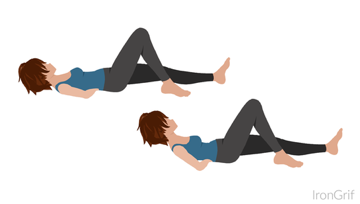Low back pain affects almost every person at some point in their life. It can limit and restrict how people go about their daily routines. Low back pain can be caused by a variety of reasons such as sports injuries, arthritis, overuse, being overweight or just physically reconditioned to a sedentary lifestyle and lack of quality movements which I commonly see in office workers. Regular physical activity and specific exercise programs can help condition the muscle groups that support the spine and provide spinal stability. When embarking on an exercise program for low back prevention, five things need to be considered:
#1 Challenge your muscles but don’t stress the spine.
A major goal that should be accomplished through low back pain exercise prevention programs is to strengthen the spinal stabilizers such as the Quadratus Lumborum, Transverse Abdominus and the Multifidus. These muscles support the spine and help us stand up and move about. If they are weak, we put undue stress on the discs and the facet joints causing damage. Also, we need to exclude any exercise that puts compressive load on the spine. An example of an exercise that works your entire core while not loading the spine excessively is the “bird dog”.
#2 Move slowly through ranges at a controlled speed
When doing exercises think of a slow controlled tempo. Unless you are working explosive power such as plyometrics the ground foundations are needed otherwise you will injure yourself. If you move slowly through your ranges, you increase the time under tension which has a greater strength benefit than doing the exercise incorrectly and hurting yourself.
#3 It is not a race
Every exercise is a great exercise if done correctly and performed well. Sometimes we are too impatient and jump into exercises that are too advanced for what we are capable of doing or unable to control which leads to injury. The only competition in building strength with your body is yourself.
#4 Never work through pain
Pain is the brain’s perception of what is going on in its surrounding environment. It is different for each individual. It can be a precursor to something that is going to be detrimental to the body i.e. injury or can be the sensation that you get when you’re working hard i.e. exercise induced soreness. If you exercise through pain, your body will work around what it has to and is able to do. This means that you will activate different muscle groups and firing patterns to achieve the desired movement but in the long term this can be detrimental to your body as a whole because you now have compensatory patterns on top of the original pain syndrome. If you feel pain during a specific exercise, give feedback to your healthcare provider or trainer and ask them for an alternative or a regression from the exercise.
#5 Consistency is key
Muscles grow and adapt to the stress (i.e. an exercise) that is put upon them. If you stop activating them, they then start to decondition again. Making regular exercise part of your life will help you to keep muscle gains. Exploring your body and challenging it to its capable limits lets us move more efficiently through life. Being able to move your own body mass around by hanging, pulling and squatting is the basis to any exercise program. Keeping your body moving will help to build and maintain strength.
Try these 3 following exercises to help prevent low back pain:
Bird Dog
Start with both hands and knees on the floor. Keep the head and back in a straight position. Abdominal hollow and posterior tilt the pelvis. Have hands under your shoulders and hips directly above your knees. Next slowly raise one arm forward to shoulder level, whilst simultaneously lifting opposite leg off the ground, extending the leg to hip height. Pause momentarily. Return to start position and then alternate sides. Maintain a straight spine, don’t allow your hips to rotate or twist and do not arch the lower back (hyperextend). Do for 60 seconds at a slow controlled speed, rest for 2 minutes and then repeat the exercise again for 60 seconds.
McGill Curl Up
Begin with lying on your back with one knee bent. Place both hands
underneath your low back with palms down. Slowly tuck your chin to your chest and then lift your shoulders off the ground. Try to maintain a neutral spine position without rounding of the low back. This is not a sit up! Elbows can maintain contact with the ground during the movement. Pause momentarily. Return to start position. Do for 60 seconds at a slow controlled speed, rest for 2 minutes and then repeat the exercise again for 60 seconds.

Hip Bridge
Begin lying on your back with both knees bent and feet on the floor. Have your arms extended beside your body. Posterior pelvic tilt and engage your core muscles and gluteals. Slowly start to lift your hips of the floor to a height that you are comfortable with. Ideal is have a bridge that is flat through the shoulders, abdomen and down the thighs to the knees. Pause momentarily at your maximal height. Slowly return to the start position. Do for 60 seconds at a slow controlled speed, rest for 2 minutes and then repeat the exercise again for 60 seconds.

Initially you may develop a cramping sensation in the back of the thighs (hamstrings). Make sure gluteals are engaged first before lifting can help this or only lifting to the height you feel comfortable with at first till you build the strength required. Otherwise stretching the hamstrings for 30 seconds each side before may eliminate this sensation.
If you have any questions or would like to be assessed, please contact Neurohealth on 9905 9099 or email at admin@neurohealthchiro.com.au
By Steven Cannon – Chiropractor Neurohealth Chiropractic




